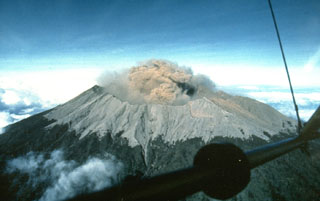Report on Raung (Indonesia) — 24 June-30 June 2015
Smithsonian Institution / US Geological Survey
Weekly Volcanic Activity Report, 24 June-30 June 2015
Managing Editor: Sally Sennert.
Please cite this report as:
Global Volcanism Program, 2015. Report on Raung (Indonesia) (Sennert, S, ed.). Weekly Volcanic Activity Report, 24 June-30 June 2015. Smithsonian Institution and US Geological Survey.
Raung
Indonesia
8.119°S, 114.056°E; summit elev. 3260 m
All times are local (unless otherwise noted)
PVMBG reported that, during times of clear weather during 1-28 June, white plumes were observed rising as high as 300 m above Raung's crater rim. Rumbling was frequently heard at the observation post. Seismic tremor sharply increased on 21 June, and crater incandescence was observed on 25 and 28 June. BNPB reported that increased activity on 28 June was characterized by Strombolian activity, roaring, ash plumes that rose 300 m, and a loud thumping sound heard 20 km away at 2000. Incandescence from the crater was clearly visible from the observation post in Banyuwangi. PVMBG raised the Alert Level to 3 (on a scale of 1-4) on 29 June, and reminded the public not to approach the crater within a 3-km radius.
Geological Summary. Raung, one of Java's most active volcanoes, is a massive stratovolcano in easternmost Java that was constructed SW of the rim of Ijen caldera. The unvegetated summit is truncated by a dramatic steep-walled, 2-km-wide caldera that has been the site of frequent historical eruptions. A prehistoric collapse of Gunung Gadung on the W flank produced a large debris avalanche that traveled 79 km, reaching nearly to the Indian Ocean. Raung contains several centers constructed along a NE-SW line, with Gunung Suket and Gunung Gadung stratovolcanoes being located to the NE and W, respectively.
Sources: Pusat Vulkanologi dan Mitigasi Bencana Geologi (PVMBG, also known as CVGHM), Badan Nacional Penanggulangan Bencana (BNPB)

